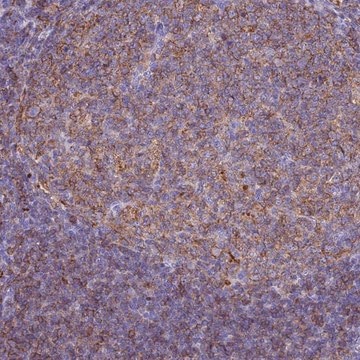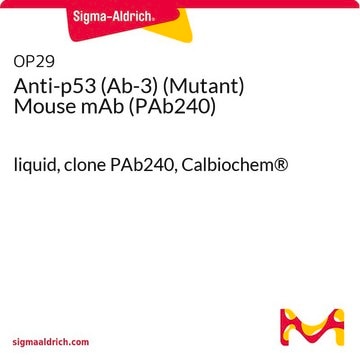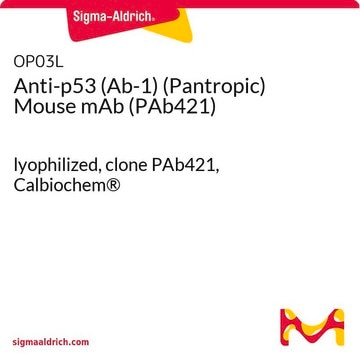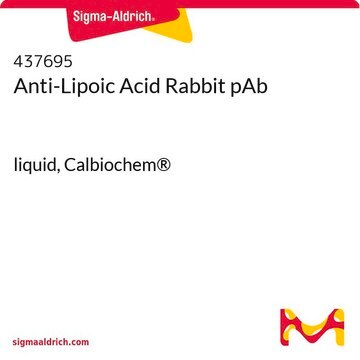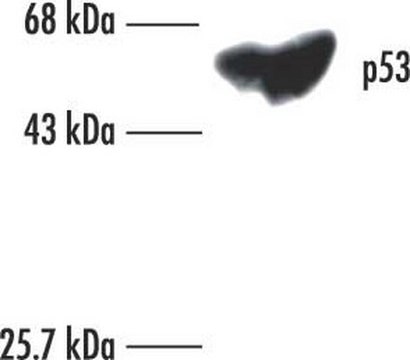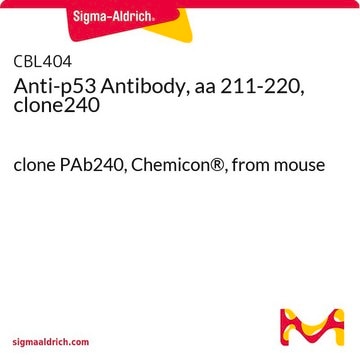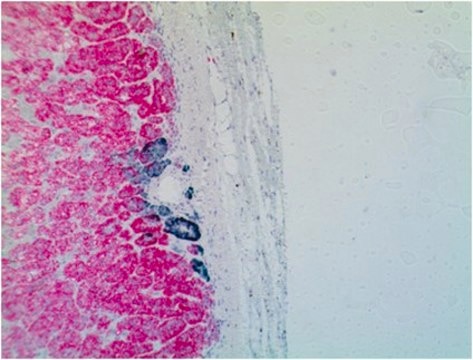OP03
Anti-p53 (Ab-1) (Pantropic) Mouse mAb (PAb421)
liquid, clone PAb421, Calbiochem®
Sign Into View Organizational & Contract Pricing
All Photos(1)
About This Item
UNSPSC Code:
12352203
NACRES:
NA.43
Recommended Products
biological source
mouse
Quality Level
antibody form
purified antibody
antibody product type
primary antibodies
clone
PAb421, monoclonal
form
liquid
contains
≤0.1% sodium azide as preservative
species reactivity
rabbit, monkey, human, mouse, rat
manufacturer/tradename
Calbiochem®
storage condition
do not freeze
isotype
IgG2a
shipped in
wet ice
storage temp.
2-8°C
target post-translational modification
unmodified
Gene Information
human ... TP53(7157)
General description
Purified mouse monoclonal antibody generated by immunizing mice with the specified immunogen and fusing splenocytes with NS1 mouse myeloma cells (see application references). Recognizes the ~53 kDa mutant and wild-type p53 proteins.
Recognizes the ~53 kDa mammalian wild-type and mutant p53 protein. Does not recognize phosphorylated or acetylated p53.
This Anti-p53 (Ab-1) (Pantropic) Mouse mAb (PAb421) is validated for use in Frozen Sections, Gel Shift, Immunoblotting, IF, FC, IP for the detection of p53 (Ab-1) (Pantropic).
Immunogen
Epitope: within amino acids 376-378 of human p53
Mouse
partially purified mouse p53
Application
Frozen Sections (10 µg/ml, see application references)
Gel Shift (see comments)
Immunoblotting (10 µg/ml, see application references)
Immunofluorescence (1-20 µg/ml, see application references)
Flow Cytometry (1-20 µg/ml)
Immunoprecipitation (1 μg per sample, see application references)
Gel Shift (see comments)
Immunoblotting (10 µg/ml, see application references)
Immunofluorescence (1-20 µg/ml, see application references)
Flow Cytometry (1-20 µg/ml)
Immunoprecipitation (1 μg per sample, see application references)
Packaging
Please refer to vial label for lot-specific concentration.
Warning
Toxicity: Standard Handling (A)
Physical form
In 50 mM sodium phosphate buffer, 0.2% gelatin, pH 7.5.
Analysis Note
Negative Control
SK-OV-3 cells or normal skin
SK-OV-3 cells or normal skin
Positive Control
Breast carcinoma, A431 cells, or p53 standard (Cat. No. 506147)
Breast carcinoma, A431 cells, or p53 standard (Cat. No. 506147)
Other Notes
El-Deiry, W.S., et al. 1994. Cancer Res.54, 1169.
Greenblatt, M.S., et al. 1994. Cancer Res.54, 4855.
Legros, Y., et al. 1994. Oncogene9, 2071.
Barak, Y., et al. 1993. EMBO J.12, 461.
Kuerbitz, S.J. 1992. Proc. Natl. Acad. Sci. USA89, 7491.
Kastan, M.B., et al. 1992. Cell71, 587.
Lane, D.P. 1992. Nature358, 15.
Kastan, M.B., et al. 1991. Cancer Res.51 6304.
Crawford, L. and Harlow, E. 1982. J. Virol.41, 709.
Harlow, E., et al. 1981. J. Virol.39 861.
Greenblatt, M.S., et al. 1994. Cancer Res.54, 4855.
Legros, Y., et al. 1994. Oncogene9, 2071.
Barak, Y., et al. 1993. EMBO J.12, 461.
Kuerbitz, S.J. 1992. Proc. Natl. Acad. Sci. USA89, 7491.
Kastan, M.B., et al. 1992. Cell71, 587.
Lane, D.P. 1992. Nature358, 15.
Kastan, M.B., et al. 1991. Cancer Res.51 6304.
Crawford, L. and Harlow, E. 1982. J. Virol.41, 709.
Harlow, E., et al. 1981. J. Virol.39 861.
Originally called clone L21. Does not recognize phosphorylated p53. For a gel shift assay, use Cat. No. OP03L and resuspend in 100 µl buffer. Wild-type p53 has a short half-life and is present in low amounts in cells. For immunoprecipitation, increasing the amount of sample to be immunoprecipitated and applied to the gel may help visualize wild-type p53, and short incubation times with 35S-Met (≤1 h) will help reduce background. For immunoblotting of wild-type p53, maximize sensitivity by concentrating samples by immunoprecipitation with Cat. No. OP03, then immunoblot using PC35 and chemiluminescent detection. This antibody recognizes the region encompassing Ser376 to Ser378 (see application references) and does not recognize phosphorylated p53 (see application references). Antibody should be titrated for optimal results in individual systems.
Legal Information
CALBIOCHEM is a registered trademark of Merck KGaA, Darmstadt, Germany
Not finding the right product?
Try our Product Selector Tool.
wgk_germany
nwg
flash_point_f
Not applicable
flash_point_c
Not applicable
Certificates of Analysis (COA)
Search for Certificates of Analysis (COA) by entering the products Lot/Batch Number. Lot and Batch Numbers can be found on a product’s label following the words ‘Lot’ or ‘Batch’.
Already Own This Product?
Find documentation for the products that you have recently purchased in the Document Library.
Sricharan Bandhakavi et al.
Molecular & cellular proteomics : MCP, 9(2), 403-414 (2009-12-04)
Cellular nutritional and energy status regulates a wide range of nuclear processes important for cell growth, survival, and metabolic homeostasis. Mammalian target of rapamycin (mTOR) plays a key role in the cellular responses to nutrients. However, the nuclear processes governed
Rachel E Rempel et al.
PLoS genetics, 5(9), e1000640-e1000640 (2009-09-15)
The phenotypic heterogeneity that characterizes human cancers reflects the enormous genetic complexity of the oncogenic process. This complexity can also be seen in mouse models where it is frequently observed that in addition to the initiating genetic alteration, the resulting
P J Grippo et al.
The American journal of pathology, 157(3), 805-813 (2000-09-12)
Transitional cell carcinoma (TCC), a neoplasm of urinary bladder urothelial cells, generally appears in either of two forms, papillary non-invasive or invasive TCC, although intermediate forms can occur. Each has a distinctive morphology and clinical course. Altered expression of the
Sun-Young Choi et al.
International journal of oncology, 40(1), 277-286 (2011-09-03)
Proteins involved in the G1 phase of the cell cycle are aberrantly expressed, sometimes in mutated forms, in human cancers including human hepatocellular carcinoma.
C J Chiou et al.
Journal of virology, 67(10), 6201-6214 (1993-10-01)
The 80-kDa IE2 nuclear phosphoprotein encoded by the human cytomegalovirus (HCMV) major immediate-early (MIE) gene behaves both as a nonspecific transactivator of heterologous reporter genes and as a specific repressor of its own promoter-enhancer region. To begin to examine the
Our team of scientists has experience in all areas of research including Life Science, Material Science, Chemical Synthesis, Chromatography, Analytical and many others.
Contact Technical Service
